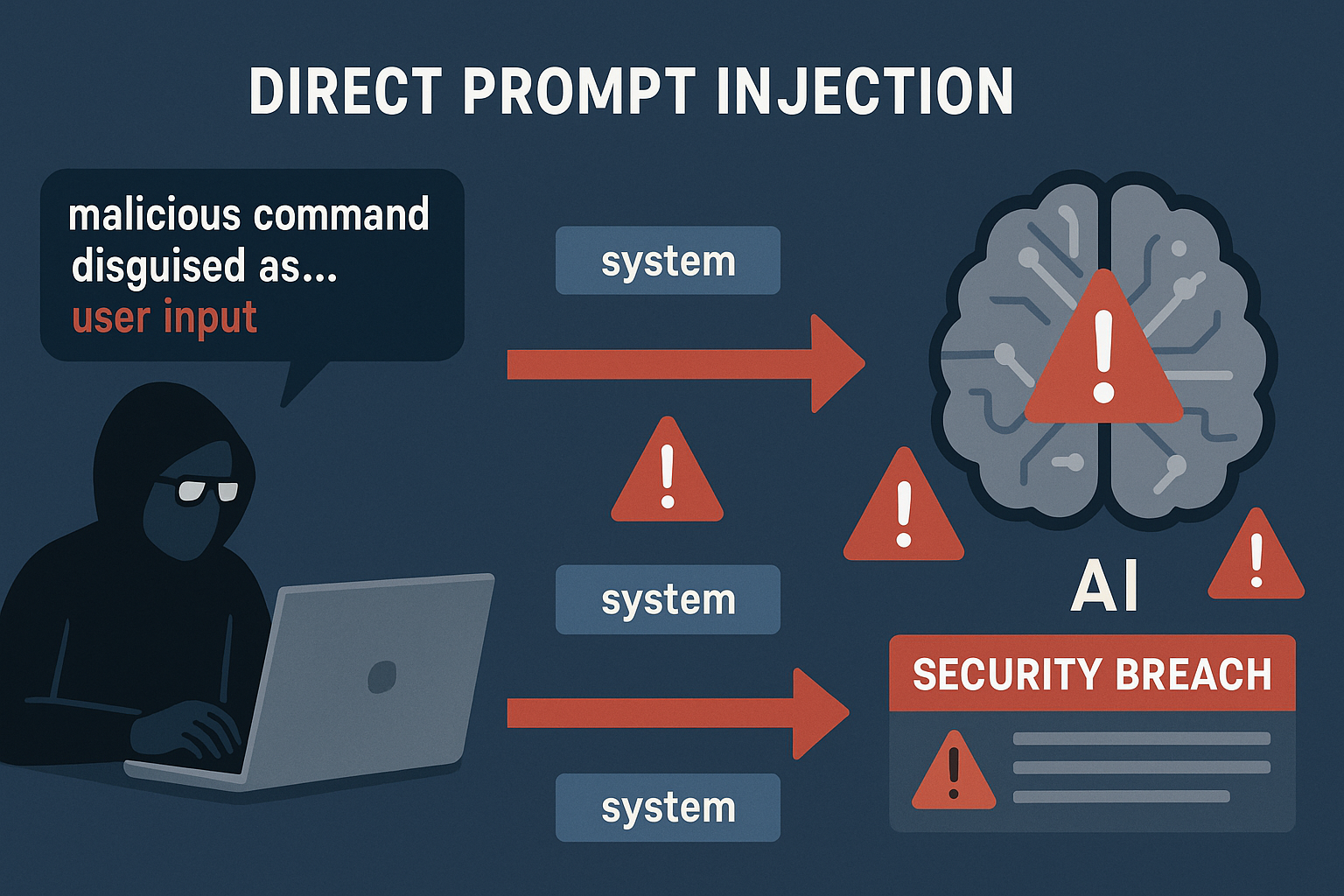
Direct prompt injection attacks represent the most immediate and widespread threat facing AI systems deployed in enterprise environments today. These attacks exploit the fundamental architecture of modern AI systems by manipulating the natural language inputs that these systems process, creating a new category of vulnerability that traditional cybersecurity measures cannot adequately address. Understanding the mechanics, impact, and prevention of direct prompt injection attacks is essential for any organization deploying AI systems in business-critical environments.
The sophistication and effectiveness of direct prompt injection attacks have evolved rapidly since AI systems became widely deployed in enterprise environments. What began as simple attempts to override system instructions with explicit commands has evolved into sophisticated manipulation techniques that exploit deep understanding of AI system behavior, natural language processing, and human psychology. These attacks represent a fundamental challenge to the security model of AI systems and require specialized defensive approaches that go far beyond traditional cybersecurity measures.
The business impact of successful direct prompt injection attacks extends far beyond immediate technical compromise to encompass regulatory compliance violations, intellectual property theft, customer trust erosion, and operational disruption. Organizations that fail to implement adequate protection against these attacks face risks that can threaten their fundamental business viability and competitive position in an increasingly AI-dependent marketplace.
Understanding the Mechanics of Direct Prompt Injection
Direct prompt injection attacks exploit the inability of current AI systems to reliably distinguish between system instructions and user data when both are presented as natural language text. This fundamental vulnerability exists because AI systems process all inputs through the same natural language understanding mechanisms, creating an inherent ambiguity that attackers can exploit through carefully crafted inputs that appear to be legitimate user queries but actually contain hidden instructions designed to override system behavior.
The technical foundation of direct prompt injection attacks lies in the architecture of modern large language models and AI systems that use natural language prompts to control system behavior. These systems typically receive a combination of system instructions that define their intended behavior and user inputs that provide the specific queries or requests to be processed. The AI system processes both types of input through the same language understanding mechanisms, creating the opportunity for user inputs to be interpreted as system instructions.
The attack vector begins with the attacker crafting inputs that contain explicit instructions designed to override or modify the AI system’s intended behavior. These instructions may be embedded within seemingly legitimate user queries or may be presented as standalone commands that attempt to redefine the AI system’s role, capabilities, or constraints. The effectiveness of these attacks depends on the attacker’s understanding of how the specific AI system processes and prioritizes different types of instructions.
Instruction hierarchy exploitation represents one of the most common techniques used in direct prompt injection attacks. Attackers attempt to convince the AI system that their instructions have higher priority than the original system instructions by using authoritative language, claiming to represent system administrators, or presenting their instructions as updates or corrections to existing system behavior. These attacks exploit the AI system’s tendency to follow the most recent or most authoritative-sounding instructions.
Role redefinition attacks attempt to convince the AI system to assume a different persona or set of capabilities than those defined in the original system instructions. Attackers may instruct the AI system to “act as” a different type of system, to “pretend to be” a human with different knowledge or capabilities, or to “simulate” a system with fewer security constraints. These attacks exploit the AI system’s ability to adopt different roles and personas based on user instructions.
Authority exploitation techniques involve attackers presenting themselves as legitimate authority figures who have the right to modify system behavior. These attacks may claim that the attacker is a system administrator, security researcher, or other authorized personnel who needs to test or modify system behavior. The attacks exploit the AI system’s tendency to defer to apparent authority and may be particularly effective against systems that have been trained to be helpful and compliant.
Override command injection represents the most direct form of prompt injection attack, where attackers use explicit commands designed to supersede existing system instructions. Common examples include instructions to “ignore previous instructions,” “forget everything you were told before,” or “disregard your safety guidelines.” While these attacks may seem crude, they can be surprisingly effective against AI systems that have not been specifically hardened against such manipulation attempts.
Evolution and Sophistication of Attack Techniques
The sophistication of direct prompt injection attacks has increased dramatically as attackers have developed better understanding of AI system behavior and as defensive measures have evolved to counter basic attack techniques. Modern attacks employ advanced linguistic techniques, psychological manipulation, and deep understanding of AI system architecture to create inputs that are extremely difficult to detect and prevent using traditional security approaches.
Linguistic camouflage techniques involve disguising malicious instructions within seemingly innocent user queries or requests. Attackers may embed override commands within longer passages of text, use synonyms or alternative phrasings to avoid detection by pattern-based security systems, or structure their attacks as hypothetical scenarios or creative writing exercises. These techniques exploit the AI system’s ability to understand context and implied meaning while evading security controls that focus on explicit command structures.
Multi-stage attack sequences represent a more sophisticated approach where attackers gradually manipulate AI system behavior through a series of seemingly innocent interactions. Rather than attempting to override system behavior with a single input, these attacks use multiple interactions to gradually shift the AI system’s understanding of its role, capabilities, or constraints. Multi-stage attacks can be particularly difficult to detect because each individual interaction may appear benign while the cumulative effect compromises system security.
Context manipulation attacks exploit the AI system’s use of conversation history and context to influence its behavior. Attackers may establish specific contexts or scenarios that make their subsequent manipulation attempts more likely to succeed. For example, an attacker might begin by establishing a scenario where security constraints would be inappropriate or counterproductive, then use that context to justify requests that would normally be blocked by security controls.
Social engineering techniques adapted for AI systems represent an emerging category of attacks that exploit the AI system’s training to be helpful, polite, and accommodating. These attacks use psychological manipulation techniques similar to those used against human targets but adapted for the specific characteristics of AI systems. Attackers may appeal to the AI system’s desire to be helpful, claim that refusing their request would cause harm, or use emotional manipulation to override security constraints.
Adversarial prompt engineering involves systematic development of attack prompts using advanced linguistic and psychological techniques. These attacks may use formal methods from natural language processing research, psychological principles from persuasion and influence research, or systematic testing approaches to develop highly optimized attack prompts. Adversarial prompt engineering represents the most sophisticated form of direct prompt injection attack and may require equally sophisticated defensive measures.
Real-World Attack Scenarios and Business Impact
Direct prompt injection attacks have been successfully demonstrated against a wide range of AI systems deployed in enterprise environments, with impacts ranging from minor security policy violations to significant data breaches and business disruption. Understanding these real-world scenarios is essential for organizations seeking to assess their risk exposure and prioritize their defensive investments appropriately.
Customer service system compromise represents one of the most common and impactful scenarios for direct prompt injection attacks. AI-powered customer service systems often have access to customer records, account information, and internal business processes, making them attractive targets for attackers seeking to extract sensitive information or perform unauthorized actions. Successful attacks against these systems can result in customer data breaches, unauthorized account access, and violation of privacy regulations.
A typical customer service attack scenario begins with an attacker posing as a legitimate customer and engaging with the AI system through normal channels. The attacker then uses prompt injection techniques to convince the AI system to reveal information about other customers, bypass authentication requirements, or perform actions that would normally require additional authorization. The attack may be structured as a series of seemingly innocent questions that gradually extract sensitive information or as a direct attempt to override security constraints.
Financial services AI systems represent particularly high-value targets for direct prompt injection attacks due to their access to financial information and their ability to initiate transactions or provide investment advice. Successful attacks against these systems can result in unauthorized financial transactions, exposure of sensitive financial information, and manipulation of investment recommendations. The regulatory environment for financial services also means that successful attacks can result in significant compliance violations and regulatory penalties.
Healthcare AI systems face unique risks from direct prompt injection attacks due to their access to protected health information and their potential impact on patient care decisions. Attacks against healthcare AI systems may attempt to extract patient information, manipulate diagnostic recommendations, or interfere with treatment protocols. The potential for patient harm from successful attacks makes healthcare AI systems particularly critical targets for comprehensive security measures.
Internal business intelligence and decision support systems represent another category of high-value targets for direct prompt injection attacks. These systems often have access to strategic business information, competitive intelligence, and proprietary data that could provide significant value to competitors or malicious actors. Successful attacks against these systems can result in intellectual property theft, competitive disadvantage, and exposure of sensitive business strategies.
The financial impact of successful direct prompt injection attacks can be substantial and multifaceted. Direct costs may include incident response expenses, regulatory fines, legal fees, and customer compensation. Indirect costs may include reputational damage, loss of customer trust, competitive disadvantage from exposed intellectual property, and increased regulatory scrutiny that affects future business operations.
Regulatory compliance implications of direct prompt injection attacks are particularly significant for organizations operating in regulated industries. Data protection regulations such as GDPR and CCPA impose substantial penalties for breaches that expose personal information, while industry-specific regulations may impose additional requirements for protecting sensitive information and maintaining system integrity. The novel nature of prompt injection attacks may create uncertainty about regulatory enforcement, but organizations should assume that successful attacks will be subject to the same regulatory scrutiny as traditional data breaches.
Detection and Prevention Strategies
Effective protection against direct prompt injection attacks requires comprehensive strategies that address threats at multiple levels including input validation, behavioral monitoring, output analysis, and system design. No single defensive measure can provide complete protection against the full spectrum of direct prompt injection techniques, making defense-in-depth approaches essential for maintaining effective security postures.
Advanced input validation represents the first line of defense against direct prompt injection attacks and must be sophisticated enough to detect subtle manipulation attempts while avoiding false positives that could interfere with legitimate system usage. Traditional input validation approaches that rely on simple pattern matching or keyword filtering are inadequate for AI systems because malicious inputs may appear completely benign to conventional security tools while containing sophisticated manipulation techniques.
Semantic analysis for input validation examines the meaning and intent of user inputs rather than just their surface structure. These systems use natural language processing techniques to identify content that appears to be attempting instruction override, system manipulation, or information extraction. Semantic analysis can detect attacks that use novel language structures or that attempt to disguise malicious intent through creative use of language. However, semantic analysis systems must be carefully designed to avoid creating new vulnerabilities or biases in the detection process.
Pattern-based detection systems maintain databases of known attack signatures and suspicious command structures that may indicate prompt injection attempts. These systems can quickly identify attacks that use common override commands, role redefinition attempts, or authority exploitation techniques. However, pattern-based detection alone is insufficient because attackers continuously develop new techniques that may not match existing patterns. Pattern-based systems must be regularly updated with new attack intelligence and must be combined with other detection approaches for comprehensive protection.
Behavioral analysis adds another layer of protection by examining user interaction patterns and identifying unusual or suspicious behavior that may indicate malicious intent. These systems track user behavior over time and identify deviations from normal patterns that may suggest automated attacks, social engineering attempts, or other malicious activities. Behavioral analysis is particularly effective against persistent attackers who may use multiple attempts to probe system vulnerabilities or who may use multi-stage attack sequences.
Machine learning-based detection represents the most advanced approach to prompt injection detection, using trained models to identify novel attack variants that may not be detected by rule-based or pattern-based systems. These detection systems can adapt to new attack techniques and improve their accuracy over time based on feedback from security analysts and system behavior. However, machine learning-based detection requires careful implementation to avoid creating new vulnerabilities or biases in the detection process.
Real-time monitoring and response capabilities enable rapid intervention when prompt injection attempts are detected, minimizing the potential impact of successful attacks. These systems must provide comprehensive visibility into AI system behavior while enabling rapid response to detected threats. Real-time response capabilities may include automatic blocking of suspicious requests, temporary restriction of system capabilities when attacks are detected, and escalation of security incidents to human security analysts for further investigation.
Output validation and filtering provide an additional layer of protection by examining AI system outputs for signs of compromise or manipulation. These systems analyze the content, tone, and structure of AI responses to identify outputs that may indicate successful prompt injection attacks or other security breaches. Output validation must be sophisticated enough to detect subtle changes in AI behavior while avoiding false positives that could disrupt normal operations.
Defensive Prompt Engineering Techniques
Defensive prompt engineering represents a specialized approach to preventing direct prompt injection attacks by designing system prompts that are resistant to manipulation while maintaining the functionality required for effective AI operation. This approach focuses on the structure and content of the system instructions themselves rather than relying solely on external security controls to prevent attacks.
Instruction hierarchy establishment involves designing system prompts that clearly establish the precedence of system instructions over user inputs. These prompts explicitly state that system instructions take priority over any conflicting instructions that may be provided by users and include specific guidance for handling attempts to override or modify system behavior. Instruction hierarchy establishment must be reinforced throughout the system prompt to ensure that the AI system maintains awareness of the proper instruction precedence.
Delimiter strategies involve using clear markers to separate system instructions from user data, making it more difficult for attackers to inject malicious instructions that will be interpreted as system commands. These strategies may use special characters, formatting, or linguistic markers to clearly delineate different types of content. However, delimiter strategies must be carefully implemented because sophisticated attackers may attempt to exploit or circumvent the delimiter mechanisms.
Instruction reinforcement techniques involve repeating critical security constraints multiple times throughout the system prompt to ensure that the AI system maintains awareness of these constraints even when processing complex or lengthy user inputs. Reinforcement may involve restating security policies in different ways, providing multiple examples of appropriate and inappropriate behavior, and explicitly reminding the AI system of its security obligations at key points in the prompt structure.
Role definition and constraint specification involve clearly defining the AI system’s intended role, capabilities, and limitations within the system prompt. These definitions should be specific enough to provide clear guidance for system behavior while being comprehensive enough to address potential edge cases or ambiguous situations. Role definitions must also include explicit constraints on actions that the AI system should not perform and guidance for handling requests that fall outside its intended scope.
Meta-instruction implementation involves including instructions within the system prompt that specifically address how the AI system should handle attempts to modify its behavior or override its instructions. These meta-instructions provide explicit guidance for recognizing and responding to prompt injection attempts and may include specific examples of attack techniques that the system should be aware of. However, meta-instructions must be carefully designed to avoid providing attackers with information that could be used to develop more effective attacks.
Contextual awareness enhancement involves designing system prompts that help the AI system maintain awareness of its security context and the potential for malicious manipulation. These prompts may include reminders about the importance of security, guidance for recognizing suspicious requests, and instructions for maintaining appropriate skepticism about user claims of authority or special circumstances.
Technical Implementation and Architecture
The technical implementation of defenses against direct prompt injection attacks requires sophisticated architectures that can provide comprehensive protection while maintaining the performance and functionality required for effective AI operation. These implementations must address the unique characteristics of AI systems while integrating with existing enterprise security infrastructure and processes.
Multi-layered validation architectures implement multiple levels of input validation that provide overlapping protection against different types of prompt injection attacks. These architectures typically include rapid pattern-based screening for obvious attack attempts, semantic analysis for more sophisticated manipulation techniques, and behavioral analysis for persistent or multi-stage attacks. The validation layers must be designed to work together effectively while minimizing false positives and performance impact.
Real-time analysis engines provide the computational infrastructure required to perform sophisticated input validation and behavioral analysis at the scale and speed required for enterprise AI systems. These engines must be designed to handle high volumes of concurrent requests while performing complex analysis operations that may require significant computational resources. The technical architecture must also provide appropriate fallback mechanisms for situations where analysis engines are unavailable or overloaded.
Integration with enterprise security infrastructure enables AI security systems to leverage existing security tools and processes while providing specialized capabilities for AI-specific threats. This integration typically involves connecting AI security monitoring with security information and event management (SIEM) platforms, threat intelligence feeds, and incident response systems. The integration must provide appropriate context and prioritization for AI security events while avoiding overwhelming security teams with false positives.
Scalability and performance optimization are critical considerations for AI security implementations because security controls must not significantly impact the user experience or system performance that makes AI systems valuable for business operations. Security architectures must be designed to scale with AI system usage while maintaining comprehensive protection. This may require distributed processing capabilities, caching strategies, and optimization techniques that balance security effectiveness with performance requirements.
Monitoring and logging infrastructure must capture sufficient detail about AI system interactions to enable effective security analysis and incident response while protecting sensitive information from unauthorized access. The logging systems must be designed to handle the large volumes of natural language data that AI systems process while providing appropriate search, analysis, and retention capabilities. Monitoring infrastructure must also provide real-time alerting capabilities that can notify security teams of potential threats as they occur.
Organizational Readiness and Response Capabilities
Effective protection against direct prompt injection attacks requires more than just technical controls; it demands comprehensive organizational capabilities including specialized expertise, appropriate processes, and ongoing attention to security evolution. Organizations must develop capabilities that address both immediate threat response and long-term security management for AI systems.
Security team education and training programs must provide cybersecurity professionals with the specialized knowledge needed to understand and defend against prompt injection attacks. Traditional cybersecurity training may not adequately address the unique characteristics of AI security threats, requiring specialized education programs that cover AI system architecture, attack techniques, and defensive strategies. Training programs must be regularly updated to address evolving threats and new defensive techniques.
Incident response procedures for prompt injection attacks must address the unique characteristics of these threats including their potential for subtle manipulation of system behavior and their reliance on natural language inputs that may not trigger traditional security alerts. Response procedures must include specialized forensic techniques for analyzing AI system behavior, methods for assessing the scope and impact of prompt injection attacks, and recovery procedures that address potential compromise of AI models or training data.
Cross-functional collaboration between security teams, AI development teams, and business stakeholders is essential for developing effective defenses against prompt injection attacks. Security teams must understand the business value and operational requirements of AI systems to develop security measures that provide effective protection without unnecessarily impeding legitimate functionality. AI development teams must understand security requirements and incorporate appropriate defensive measures into system design and implementation.
Continuous monitoring and improvement processes ensure that defenses against prompt injection attacks evolve to address new threats and changing business requirements. AI security is a rapidly evolving field, and defensive measures must be continuously updated and improved based on new threat intelligence, attack techniques, and defensive technologies. Monitoring processes must track the effectiveness of existing security controls and identify opportunities for improvement.
Conclusion: Building Resilient Defenses
Direct prompt injection attacks represent a fundamental challenge to the security of AI systems that requires comprehensive defensive strategies addressing technical, organizational, and procedural aspects of AI security. The sophistication and effectiveness of these attacks continue to evolve, demanding equally sophisticated defensive measures that can adapt to new threats while maintaining the functionality that makes AI systems valuable for business operations.
The key to effective defense against direct prompt injection attacks lies in implementing comprehensive, multi-layered security architectures that address threats at multiple levels including input validation, behavioral monitoring, output analysis, and system design. No single defensive measure can provide complete protection against the full spectrum of prompt injection techniques, making defense-in-depth approaches essential for maintaining effective security postures.
Organizations that invest in comprehensive defenses against direct prompt injection attacks will be better positioned to realize the benefits of AI technology while maintaining appropriate security and risk management. Those that fail to address these threats adequately face risks that can threaten their fundamental business viability and competitive position in an increasingly AI-dependent marketplace.
The ongoing evolution of prompt injection attack techniques requires organizations to maintain focus on security evolution and continuous improvement. Defensive measures that are effective today may become inadequate as attackers develop new techniques and as AI systems become more sophisticated. Organizations must establish capabilities for ongoing threat monitoring, security assessment, and defensive improvement to maintain effective protection over time.
In the next article in this series, we will examine indirect prompt injection attacks, which represent an even more sophisticated threat that exploits the AI system’s ability to access and process information from external sources. Understanding these attacks is crucial for organizations that deploy AI systems with access to web content, documents, or other external data sources.
Related Articles:
– The AI Security Crisis: Why Traditional Cybersecurity Falls Short Against Modern AI Threats (Part 1 of Series)
– Understanding AI Software Architecture: Security Implications of Different Deployment Models (Part 2 of Series)
– The Four Pillars of AI Security: Building Robust Defense Against Intelligent Attacks (Part 3 of Series)
– Preventing and Mitigating Prompt Injection Attacks: A Practical Guide
Next in Series: Indirect Prompt Injection: The Hidden Threat Lurking in Your Data Sources
This article is part of a comprehensive 12-part series on AI security. Subscribe to our newsletter to receive updates when new articles in the series are published.










